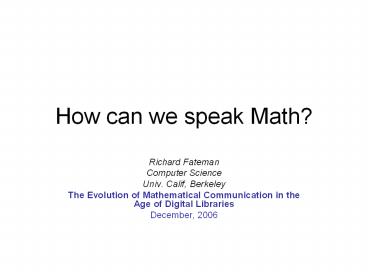How can we speak Math? PowerPoint PPT Presentation
Title: How can we speak Math?
1
How can we speak Math?
- Richard Fateman
- Computer Science
- Univ. Calif, Berkeley
- The Evolution of Mathematical Communication in
the Age of Digital Libraries - December, 2006
2
Humans speaking math into computers
- A primary input method
- Correction of errors (secondary)
- Simultaneous with handwriting, supportive of
ambiguity resolution, error correction
3
The reverse computers speaking math aloud
- AsTeR (T.V. Raman) for blind readers
- Display-free communication (e.g. telephone)
- Simultaneous with handwriting, supportive of
ambiguity resolution, error correction
4
Ambiguity and Expectation
- minus b plus or minus square root of b squared
minus 4 a c divided by 2 a . - Without prior knowledge of this formula how could
you know if the 4ac or even the 2a belongs within
the square-root? - Could it be -b ?b 2 -4ac/2a ?
- In Lisp, ambiguity is removed with one mechanism,
parentheses/prefix - (/ ( (- b) (sqrt (- ( b 2) ( 4 a c))) ( 2 a))
- (/ ( (- b) (-(sqrt (- ( b 2) ( 4 a c)))) ( 2
a))
5
Digression on math input/output
- Written Math Output
- TeX, other typesetting systems
- Interactive systems with selection
- MathML, other notations
- Not entirely solved but good enough for most work
- Written Math Input
- Traditional keyboard
- Menu selection
- Handwriting
- Mixture of above
6
Speaking math into computers
- Why bother?
- Speed. Compare
- bold italic gamma ?
- Convenience Write with hand or mouse, modify
with voice. Correction. Markup. - Keyboard-impaired users
- Note there is a trivial non-solution. Spell out
G-A-M-M-A
7
Pick a subset of the problem. Numbers are easy,
right?
- 1/10, 9/10/ 10/11
- 14/100, 14/10000
- 3/100, 300
- 34/100, 30/400
- 1-3, 1 2 3.
- 7-4-6, 7-4-1776
- Pick a number from 1, 2, 10 .
8
OK, we can delimit the speakers flexibility on
numbers. Then what?
- Still problems
- Homophones (sine, sin, sign)
- Near Homophones (p,b,t)
- Learning discrimination of ambiguous math
- a(bc)
- f(bc)
- Bracketing (), The quantity end quantity
9
Looks tough
- We believe it is not as tough as handwriting.
Grammar-based tools are part of advanced speech
recognition. - No special hardware (maybe cheap microphone,
already used for Skype etc) - Combined with selection, menu, keyboarding, looks
promising.
10
What next
- Continued development of tools and interfaces
(Lisp, .net) - Relying on technology from other domains (fun,
frustration) - Integration with Computer Algebra Systems, Math
Browsers, Education projects, Disabled-access

